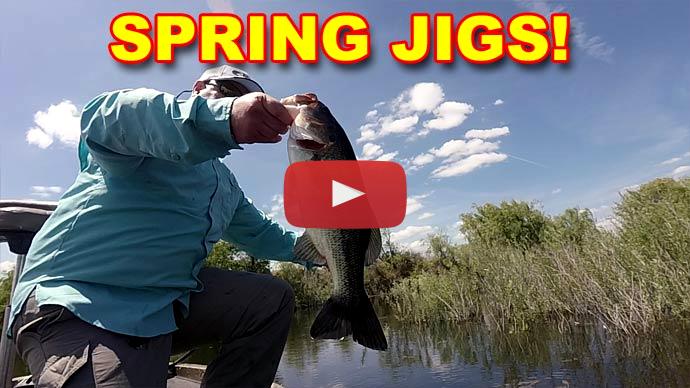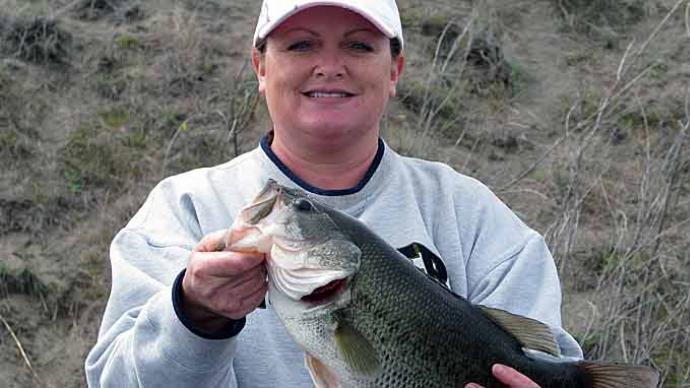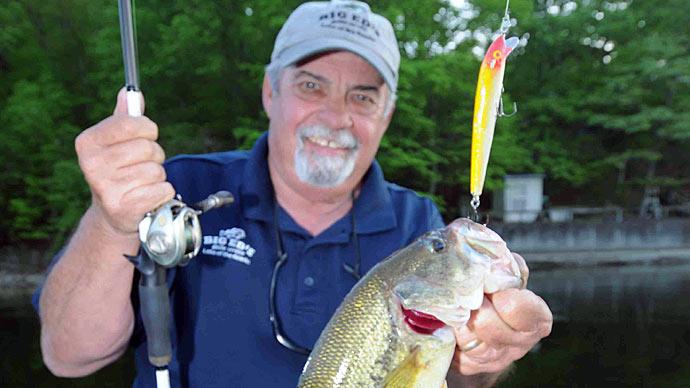Glenn: Boy, he came out and smacked it hard. Come here, you. Got you on a jig, buddy. This is a good one. Got a face full of jig right there. It's a good fish. He wanted it. Boy, he wanted it. That works. We'll let you go, little buddy. Here we go.
Hey, folks, Glenn May here with BassResource.com. And today, I wanna talk about the top five baits that I use throughout the springtime to catch fish. Now, understand, there's a lot more other baits out there that work throughout the spring, so if I don't mention your favorite bait, don't get upset. But I'm talking about the top five baits that are effective from early spring, all the way through to post-spawn, that you can use effectively the entire time.
So, let's start with the jig. The jig is probably the most versatile lure you can have in your arsenal. It works year-round, but especially works well in the spring because the bass during this whole wintertime...crawdads have been buried up in the mud, they've been essentially hibernating, and haven't been available to the bass. And those are protein-rich, slow-moving snacks that they love to feed on, especially as they're getting ready for the spawn. And so, in the early spring, a jig is perfect for those conditions because it resembles a crawdad. But even throughout the spring, these fish will continue to feed on them, so it's effective lure to use all the way through to the post-spawn.
So, I'll use a jig, starting out at the beginning of the season out on those deeper main lake points and secondary points, fishing it very slowly. And I'll use a larger-sized jig with a bulky trailer on it because I want it to look like a nice, big meal for them. That's an easy target because it's moving super slow. It's hard for them to resist that in this time of year.
So, I'll fish that way early in the season, and then as I move shallower, as the season progresses, I'll start targeting every kind of cover that I can see, usually, with a 3/8-ounce jig with a Rage Craw trailer on it. I'm targeting stumps, laydowns, pockets of weeds, points in weeds, docks, and I'm also looking at the creek channels. If the creek bend swings up right next to the shoreline you got that steeper drop, that's a great area to fish jigs, or on the inside bends of creeks back in the coves when it's kind of a flat...if it's got cover on it, especially, like stump field, or chunk rock, or maybe some weeds on it, that's a great place to target jigs during the spring.
And then, even during the spawn, you can throw jigs on top of beds and get bit that way. And even during the post-spawn, I like to throw jigs right up into balls of fry, and a lot of times, there's bass that are guarding those fry, and they'll come up and smack me, and you can catch them that way.
I only ask if you're catching fish during the spawn or post-spawn and they're guarding fry, please release immediately so they can finish doing their thing to ensure a successful spawn.
Now, the next bait that I like to use throughout the spring is a crankbait. During the early part of the season, I'm using a deeper-dive crankbait to target those deeper structure areas that I mentioned earlier. Great effective way to fish. And that's when, you know, water temps are in the mid to upper 40s, I'll start using a crankbait then. Yeah, fish will bite them, absolutely. So, that's a great way to fish those deeper areas, and I crisscross those points and crisscross those ledges and drop-offs with those deeper-diving crankbaits.
As the fish gets shallower and they get more active, I'll switch over to a lipless crankbait like a chrome with blackback or a chrome with blueback, lipless crankbait, and I like to fish the outside weed lines or just the emerging weeds, like, big flats where the milfoil and the hydrilla are just starting to grow. It's a great area to just burn a lipless crankbait across the top of it, particularly if there's something...another piece of structure there. Say, for example, some boulders are scattered around, or logs, or maybe some stumps, something like that. I'll bring that Rat-L-Trap right over the top of them or right next to them, and sometimes I'll just kill it right next to it, and the bass will just crush it.
Another great bait to use during the springtime is a spinnerbait, and I like to use it throughout the spring. Starting when the water temperature gets in the upper 40s, I'll start using a 3/4-ounce spinnerbait, and I'm throwing that in deeper water, again, those same points, ledges and humps that I was targeting earlier in, you know, 20 feet of water, 15 to 30 feet of water, targeting with a spinnerbait, slow-roling it very slowly, and crisscrossing those areas. A lot of times, what I'll do is I'll graph over the tops of those areas first to see if there's any cover that might hold those fish, like chunk rock, boulders, maybe some irregularities in the point, and I'll bring the spinnerbait right across those areas. And a lot of times, you get bit.
You don't see the bass on your graph, but there'll be hiding...they'll be so tight to that cover that they'll just appear as that piece of cover. That's okay, just target that cover and a lot of times you'll get bit.
As the spring progresses, I'll start moving up shallower, I'll target those secondary points, those deeper weed lines. I'm looking for deeper, submerged structure or cover such as flooded bushes, flooded timber, that sort of thing. And then, as we get even further into the spring where it gets really shallow, now I'm going across the flats. I like to bring it across the flats two different ways. One is a medium retrieve. If there's weeds that are submerged or any kinda cover, I'll bring it nice and slow across that. Or if the fish are really aggressive, I'll bring it back really fast. I'll burn that spinnerbait back so quickly that it's just under the surface where it's kinda bulging the surface, but not breaking it. It's a great way to fish it. They react to it. They'll be sitting in those weeds and just suddenly, boom, it just comes flying over their head, and they'll just react to it and crush it. So, it's a real fun way to catch a lot of fish quickly and cover a lot of water effectively, just bulging the surface and covering a lot of water.
But a spinnerbait to me is one of the more effective ways to catch bass throughout the entire spring because you can slow-roll it on the outside weed lines. When a front has come through, and those fish are pulled off, and they're a little bit deeper, and they're buried up in those weeds, and they don't wanna attack baits that much, you can drop it down at 10 to 15-foot zone on the outside weed line and slow-roll it past those bass that are sitting buried in those weeds. Or if maybe there's some submerged bushes, or flooded bushes, maybe some timber or something that's deeper, just bring it right by that nice and slow with a slow-rolled spinnerbait during a cold front condition. And I don't know what it is, but even though those fish seem to be lethargic and unwilling to chase baits, they'll come up and crush those spinnerbaits even under cold front conditions. So, it's a very effective way to catch fish during those tough conditions.
But then, even during the spawn, I'll bring those spinnerbaits right over the top of the beds like I did with the lipless crankbait, and I'll bring them through balls of fry during the post-spawn to catch those males that are guarding fry. Again, please release them right away so they can finish their spawn.
There you go. Nice. They're in here.
Keri: Come here, you. Glenn’s getting’ in the net. Come here, baby. Come here, come here. Oh, come on, Glenn. Come on, Glenn. There we go. There we go. He's got a sore on his tongue. Yeah, he does.
Glenn: The next bait, the fourth one on my list that I use throughout the spring is a Senko, you know, or a YUM Dinger, soft plastic jerkbait or stickbait, depending on what you wanna call them.
I'll start using them even in the early spring when it's, you know, mid to upper 40s to low 50s. I like to put them on a split shot on a smaller size, like a 3-inch, maybe 4-inch, but a 3-inch Senko on a split shot or a drop shot, and to target those deeper structure areas, like I mentioned earlier, in the early spring, those main lake points, secondary points, drop-offs, humps, those things. I can work those areas very slowly, methodically. When those fish are still a little lethargic, kinda just waking up out of their winter slumber, this is a great way to attack those areas and catch a lot of fish. It also is a very effective way to fish when a cold front has come through and those fish aren't as willing to bite faster-moving lures or bigger lures. I downsize and using those finesse tactics to target throughout the spring is a great way to...because they don't have a lot of action to them, a lot of movement, which is what you're matching, the environment and environmental conditions during the post-front conditions. So, it's a real effective way to catch them.
But if I'm not fishing those post-front conditions and the water temperature’s now has got in to the low to mid 50s, now I start using a 4 and 5-inch size stickbait, Texas-rigged with a 2/0 hook, weightless. And I'll throw it around all those areas of cover that I mentioned previously, all that stuff you can see that I mentioned before, those rocks, those stumps, laydowns, targeting from the cove entrances, all the way into the back of the bays as the spring progresses into the...the temperatures would go up into the upper 50s and the low 60s and the fish are really shallow. It's really hard to beat these baits during that time of year because they're so effective, they have such a natural, easy fall to them.
Just throw it out there on a slackline and let it fall by itself. Don't do a whole lot of work, jerking it and doing all kinds of stuff, let it fall on slackline, and it falls horizontally just on its own.
The key with that is watching your line. A lot of people gut-hook fish on these baits because they're not paying so close attention to their line. Watch your line, you're gonna see it just suddenly give a little twitch or it'll start speeding off all of a sudden it'll just start moving away from you quickly. Just any kind of movement like that...well, you didn't impart on it with your rod, so something on the other end did, and it's probably a fish. So, when you see that, reel up all that slack and set the hook as quick as you can before they swallow it. And you can catch a lot of fish that way without getting them gut-hooked. That's the number one problem with these baits, but they're very, very effective.
You know, again, this is why fish like them so much, because they really do think it's something natural, they eat it right away, they just suck it right down. So, great bait to use throughout the entire spring.
There we go. There we go. Okay. Come on in. Got a little belly on him, he has been eating. That worked. Nice bright bluebird day, why not throw a buzzbait? Clear water.
And then, finally, during the spring, another type of bait that I like to use is topwater, and very specific kinda topwater. There's two specific kinds. One is buzzbait. I'll start throwing a buzzbait when the water temperature is in the upper 40s, believe it or not. But yeah, I've caught fish on buzzbaits when it's 49, 50-degree water temp over those main lake structures. It's not uncommon for a bass when they're active this time of year to come up 15 feet deep to smash a buzzbait.
The key is, is that you wanna use larger blades so you can fish it slower and put on a bulkier, more buoyant plastic trailer on it, something like a Rage Tail Space Monkey or using a 6-inch Paddle Tail, you know, swimbait on it, something big, it enables you to fish it real slow and keep it on the surface, and it offers a larger profile for the bass to find them, and locate, and crush them.
As the spring progresses, I'll downsize, I'll move a little bit smaller-sized buzzbait, and I'll go to just, like, a twin-tail trailer on it, something smaller that can move it a lot faster across the water. This is when you're in the upper 50s and the low 60s, when the fish are holding tight to shallow cover are up on those flats, actively feeding and chasing baitfish. This is a real effective way to catch them with buzzbaits, just covering a lot of water very quickly, and throwing it to all that available cover that you see.
A lot of times, the fish will come out crushing and they'll scare the bejeebies out of you because they're hiding on something that you didn't see, it was underwater. Could be a rock, could be a little indentation, maybe a ditch or something. But it's a great way to fish when the fish are actively feeding.
The other type of topwaters that I like to use is a toad and a hollow body frog. So, going on the other end of the spectrum, think of it this way, a buzzbait moves very fast across the surface. On the other end of it, you can use a hollow body frog because it sits, and floats on the surface, and doesn't move at all. So, this is a great, effective way to fish those isolated pieces of cover that the fish are holding on when they're a little more reluctant, they don't wanna chase down a bait. You can bring that frog right to it, and let it sit, and just give it little twitches with your rod tip, and make it look alive without moving it away from that cover. And you're gonna sit for 30 seconds, or a minute, or more, just let it sit, sit, sit, and then you give it a little twitch, and suddenly, bam, the fish will hit it. Surprises you because you would think they'd hit it right away, but sometimes you have to entice them or irritate them, depending on your point of view, until they finally come up and crush that frog. But you can fish that topwater really slow and get a lot of bites that way.
The in-between range between a hollow body frog and a buzzbait is a toad, like a Rage Toad. It's a real subtle movement, you can fish them slower. I fish it on a four-rod, keel-weighted hook, like a 1/4-ounce weight that's got a screw lock on it, and I can fish it nice and slow across the surface, gurgling, very subtle movements, and I can drop it into those holes and those pockets in the weeds, on those big flats, or next to a stump, or a rock, or any kinda cover, fishing along a dock and drop it right alongside the dock.
A lot of times, those fish will track it under the surface, and then when you kill it, that's when they crush it. They just can't stand it, they just can't. Just changes the action that they've been seeing, and that change of action is what triggers that bite.
You know, and it's effective at the very beginning of the spring, all the way through to where there's balls of fry in the post-spawn. A toad, a frog, and a buzzbait are my favorite topwater baits to use throughout the whole spring.
So, those are my top five baits overall for spring fishing, top five types of baits to use throughout the spring. I hope those tips help. For more tips and tricks like this, visit BassResource.com.





